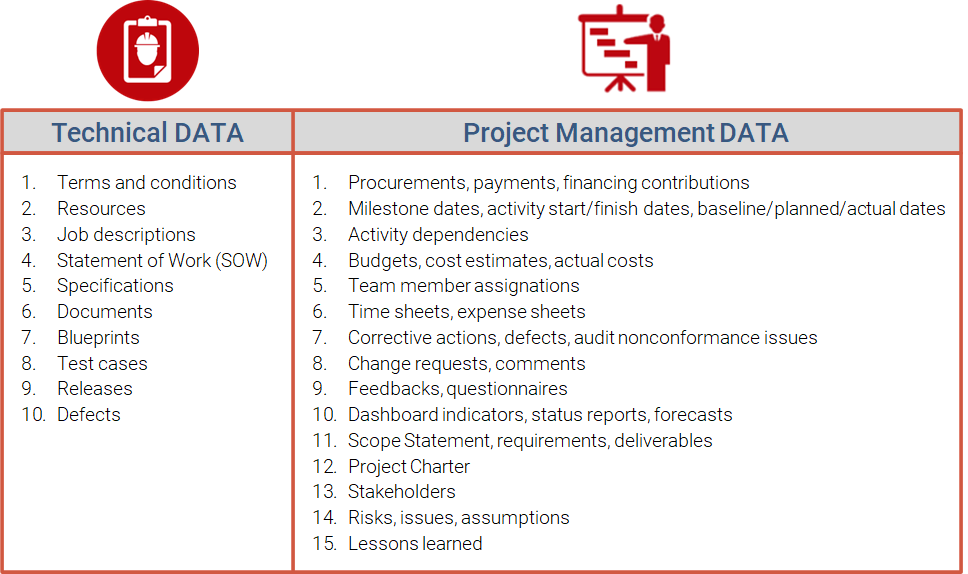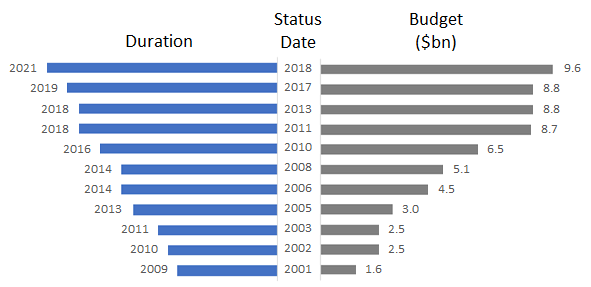Over the last 20 years, narrow AI has been applied to guess the probability of project success, mainly using regression models to estimate effort hours, durations, and costs. These developments have not been extended due to the lack of enough data sets to train algorithms.
Project management needs to change paradigms to fit the Project Economy. Project success is not just about meeting the project management goals –on time, on budget, with the right quality. It is also important to ensure that they deliver value. According to the Standard for Project Management, by PMI®, project value is defined as “The worth, importance, or usefulness of something. Different stakeholders perceive value in different ways. Customers can define value as the ability to use specific features or functions of a product. Organizations can focus on business value as determined with financial metrics, such as the benefits less the cost of achieving those benefits. Societal value can include the contribution to groups of people, communities, or the environment.”
Value driven is not easy to deliver in centralized project management structures. Focusing on value requires more and more stakeholders sharing great amount of technical data –terms and conditions. resources. job descriptions. SOW, specifications, documents, blueprints, test cases, releases, defects, etc.– and management data –procurements, payments, financing contributions, milestone dates, activity start/finish dates, baseline/planned/actual dates, activity dependencies, budgets, cost estimates, actual costs, team member assignations, time sheets, expense sheets, corrective actions, defects, audit nonconformance issues, change requests, comments, feedbacks, questionnaires, dashboard indicators, status reports, forecasts, scope statement, requirements, deliverables, project charter, stakeholders, risks, issues, assumptions, lessons learned, etc.

Every day there are more and more projects needing quick effective decision making from a big number of decentralized active stakeholders. Stakeholders create, access, and share big amounts of data, from any device, everywhere, any time. We can see a trend in project management “socialization” producing more and more project related data, getting to the levels required by AI.
Value driven and socialization could have helped the Parla’s tram project. In 2004, the City Council of Parla, in Madrid, approved the tram project, to start operating in September 2006, with an initial budget of € 93.5 million.

- Crisis of 2007: Budget increased by € 27.5 million. Tram starts operating 9 months overdue.
- Crisis of 2009: Budget increased by € 90 million.
- Crisis of 2011: Tram’s service stopped due to non-payment to the maintenance company. A payment schedule is agreed.
- Crisis of 2015: News leaked Parla tram project has an over cost of € 256 million.
Let’s imagine that the citizens of Parla, after request, had online access to the project status reports of the project since it was approved in 2004. They could request changes, send comments, etc. Would the same crisis have occurred?
Project managers are not expected to be replaced by AI. AI features will be included inside PPM software. Public Administrations will boost software evolution when critical projects or programs –e.g. NextGenerationEU– are enforced to be managed professionally.
Now let’s examine the case of the James Webb Space Telescope. This has been an extraordinarily complex innovative project. A giant scientific improvement, but also a phenomenal project management failure.

This project increased the budget from $1.6bn to $10bn, experiencing serious crisis due to poor management that were on the verge of causing its cancellation. The following figure shows the successive completion dates and budget estimates throughout the 20 years of project life:

Scientific innovation, technical issues, and external factors like covid-19, have been major issues in this project. They cannot explain, though, a final over cost of $9bn and a final delay of 12 years. Management issues would explain bad performance better. Three major agencies have joint efforts in this project: NASA, Europe Space Agency, and Canadian Space Agency. Large teams with more than 5000 team members from 17 countries at peak, and great complexity outsourced to contractors.
Chances of success for a megaproject are increased applying good practices like breaking down into value-driven projects, employing project management professionals, and relying on AI technology.
Project management success at scale means breaking big projects down into value-driven projects, employing project management professionals, and last, but not least, relying on AI technology.
Let’s go to the future, year 2030. PPM tools include AI features. NASA leads again the joint venture with ESA and CSA to put into orbit a new telescope. Estimated launching in 2035, budget estimated $1bn.
All the management teams share one PPM information system:
- The whole set of projects, thousands of them, are distributed on 3 business units: NASA, ESA, CSA. Most projects are predictive, but some of them follows adaptive and also hybrid development life cycles. Most projects are grouped into programs and portfolios. Programs and portfolios are shared between the 3 business units.
- Contractors can also use the same PPM information system to manage their projects, programs, and portfolios.
- Each project is managed by a value driven project manager professional. Each program is managed by a program manager. Each portfolio is managed by a portfolio manager.
- Throughout the 5 years, over 10,000 people enter data as team members, and about 100,000 use the role of stakeholder –NSA/ESA/CSA managers, subcontractors, astronomers, journalists, congressmen, citizens, etc.
- Team members submit time sheets and expense sheets. They can use their mobile phones to send comments, risks, etc. They use collaborative tools to manage tasks and communications.
- Stakeholders can access status reports. They can use their mobile phones to send comments, change requests, project feedback, people feedback, etc.
AI will help manage every and each individual project within this megaproject:
- A conversational bot helps initiate new projects, pending to be approved. It asks questions to set initial data, dependencies with other projects, access levels, etc. AI calculates the relative project priority inside the business unit, the program, or the portfolio.
- Program managers and portfolio managers use AI recommendations to approve the most value project set.
- AI recommends the available fittest project manager to manage the project. PM’s planning tasks are very effective: AI proactively proposes requirements, work packages, deliverables, dates, team members, activity resources, costs, etc. From data of similar projects in the past, AI initiates stakeholder register, risk register, assumption log, etc. AI sets up software tools for the project team with the right security levels.
- AI enhances project management team can annotate project performance data in real time. It also updates lessons learned and other relevant knowledge management information while the project is running.
- Project performance assessment is still evaluated by the project management team. AI optimizes elaboration of status reports. Project managers talk with a bot to get aid on performance assessment and decide corrective and preventive actions.
- Stakeholders are aware of project status real time. They can use their mobile phone to send comments, project feedback, people feedback and change requests. AI optimizes communications to stakeholders. AI ensures critical communications are timely received. AI prevents unnecessary communications to stakeholders.
- AI continually measures stakeholder satisfaction, expectations fulfillment, etc.
- AI assesses stakeholder engagement level –unaware, resistant, neutral, supportive, leading– and proposes improvement alternatives.
- AI helps monitoring and controlling risks, changes, resource planning, etc.
- AI coaches project managers. Performance background is analyzed to help project managers achieve professional development results.
- AI helps assuring contract terms are fulfilled.
When managing business units, programs, and portfolios, AI is quite effective classifying and clustering thousands of projects. AI saves a lot of time generating reports, assuring quality standards, etc. AI can answer questions like: What are the odds this project will finish on time? What is the value of this deliverable? What projects should be re-baselined? What teams should be restructured? What contracts should be canceled?
In summary, we can say that project value delivery at scale requires technology usage and socialization of more and more project stakeholders. Project technology in the form of PPM tools, narrow AI and blockchain, will aid professionals, but it will not replace them.
The chart below represents some of the best practices advisable to increase the chances of success to manage large and complex projects –also valid for organizations with too many projects:

Every day there are more and more projects needing quick effective decision making from a big number of decentralized active stakeholders who can share and access big amounts of data, from any device, everywhere, anytime. We can see a trend in project management “socialization” producing more and more project related data.
PMPeople is the tool for the project economy. It is aimed to unify professional project management by these differential points:
- Designed by and for professional project managers, following professional project management standards.
- Online productivity –less meetings, less documents, less workflows– through distributed collaboration among 12 specialized roles: Organization Owner, 6 roles on demand management and 5 roles on supply management.
- Freemium product –unlimited time, unlimited users– usable via web and mobile application.
Start using PMPeople for free, for unlimited time and for any number of users. In premium organizations, only managers have a cost. Several roles –stakeholders, team members, sponsors and resource managers– are always free. You can increase, or decrease your premium seats according to the organization actual needs. Premium organizations have access to our interactive support through Slack. Our servers are located in EU. This software can also be hosted on customer premises.
Jose Barato
Related posts
Categories
- Business (16)
- Demand Management Roles (14)
- Frequently Asked Questions (7)
- Guide (26)
- People (23)
- Assignments (2)
- Feedback (2)
- Project Team (3)
- Tracking Time And Expenses (2)
- Process (9)
- Closing (2)
- Executing And Controlling (2)
- Planning (1)
- Project Management (67)
- Management Frameworks (18)
- Organization Owner (OO) (3)
- Project Economy (54)
- Tools (19)
- Supply Management Roles (5)
- Training (6)
- Uncategorized (1)





